Like a trusted rain jacket or trustworthy tent, a sleeping bag is high on the essential backpacking gear checklist. Single sleeping bags are the norm, even for kiddos, but double sleeping bags are a fantastic alternative for couples (and/or close friends) who want to keep those cozy home vibes going in the backcountry, too.
With more double sleeping bag options that are suitable for both backpacking and car camping, we're here to help guide you towards sleeping bag success. So what is a double sleeping bag? As simple as it sounds, it’s a sleeping bag specially designed to keep two campers warm on cold nights outside—or one person and a dog, or one person who prefers plenty of room while they sleep. Below, our top picks for the best double sleeping bags currently available. Enjoy, and happy camping!
[Looking to really maximize comfort on your next camping trip? Try a camping cot.]
Field Mag's Top Picks for Best Double Sleeping Bag
-
Best Overall Double Sleeping Bag
Big Agnes King Solomon Double Sleeping Bag -
Best Luxurious Double Sleeping Bag:
Nemo Jazz Synthetic Double Sleeping Bag -
Best Budget Double Sleeping Bag:
North Face Wawona Bed Double Sleeping Bag -
Best Synthetic Double Sleeping Bag:
REI Co-op Siesta Hooded 20 Double Sleeping Bag -
Best Double Sleeping Bag for Summer:
Hest Double Synthetic Comforter -
Best Double Sleeping Bag for Winter
Feathered Friends Spoonbill Double Sleeping Bag -
Best Double Sleeping Bag for All-Season Backpacking
Feathered Friends Penguin YF 20r -
A Versatile Option for Coupled Up Campers that Often Go Solo
Western Mountaineering Ultralite -
Best Two-Person Quilt
Zenbivy Core Quilt + Core Shee
What to Consider When Buying a Double Sleeping Bag
Temperature Rating
The manufacturers of sleeping bags usually include a temperature rating on its product listing, which tells you the weather conditions it is meant to withstand. A rating of 30° F would indicate it could keep you warm even if you’re sleeping when it’s below freezing outside. After testing dozens of sleeping bags over the last few years, though, I can confidently say that manufacturers usually overpromise how warm their bags will keep you. That’s why we list a “Temperature Rating” and a “Temperature Recommendation.” The latter is the minimum temperature we think the bag is warm enough to handle.
Weight
Since a double sleeping bag is at least twice as big as a single sleeping bag, they can weigh a lot. A thicker, heavier bag can be a bit more comfortable to sleep in, but can weigh you down a lot if you have to carry it in a pack. To determine how heavy of a sleeping bag you should buy, think about the circumstances in which you’ll be using it. If you’ll be hiking it into a campsite, anything over 5 pounds might be too heavy. If you’re going to be using it on multi-day thru hikes, it might be worth looking for an option that’s even lighter. Of course, if you’re only planning to use your double sleeping bag on car camping trips, it’s probably okay to go for a heavier, more feature-rich sleeping bag.

Image courtesy Kelty
Design Features
Modern double sleeping bags come with a lot of features that are designed to provide a comfortable sleep experience for both parties, even those with different preferences. Internal sheets, two-way zippers that function as vents, and hood and collar adjustments allow both parties to customize their side of the bag without impacting the other person. Some even have sleeves to hold camp pillows and sleeping pads in place and pockets for items like a phone.
How I Tested Double Sleeping Bags
I tested these double sleeping bags during several camping trips with my partner in Grand Teton National Park and Bridger Teton National Forest in June. We primarily used them in our slide-in, pop-up camper (that does not have heat at the moment), but we also tried a few in a tent. During the day, we had the chance to evaluate how well (if at all) the sleeping bags allay heat. At night, the temperatures dropped to levels between 20 and 40 degrees, which allowed us to really see whether the bags would actually perform as well as their ratings would indicate.
The 9 Best Double Sleeping Bags of 2025
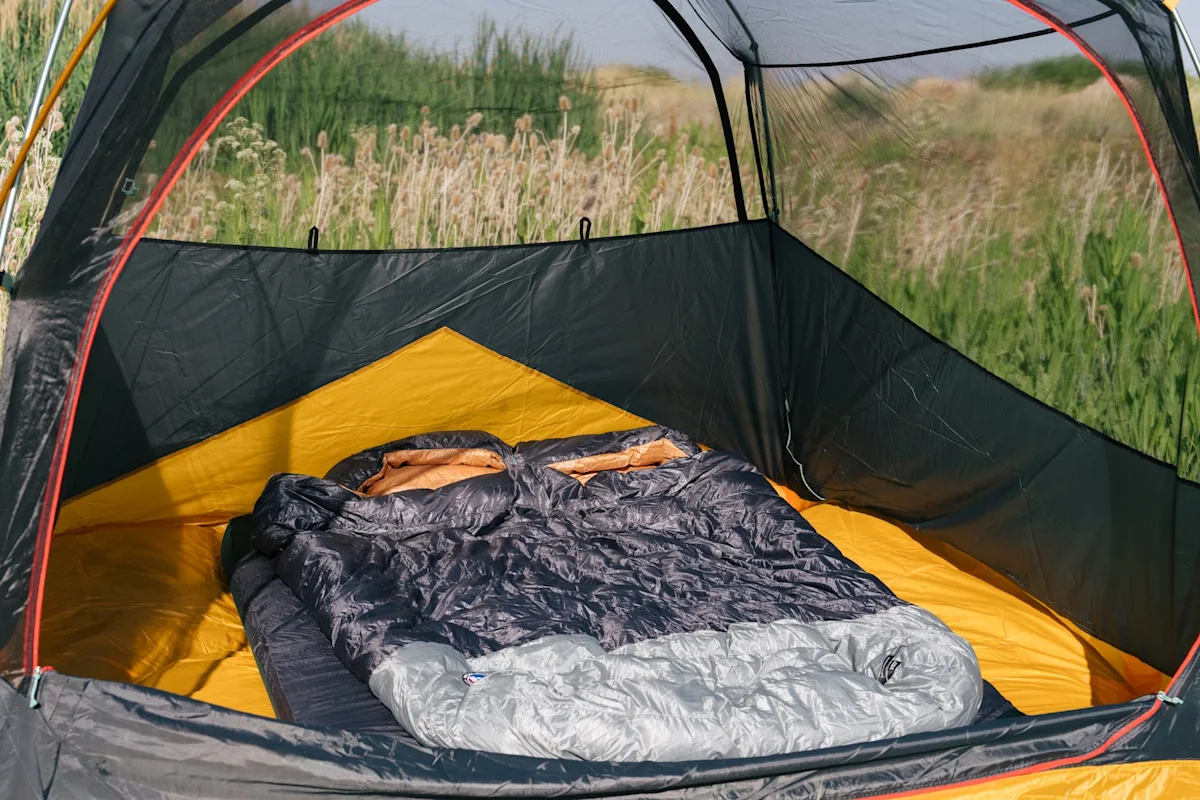
Big Agnes King Solomon Double Sleeping Bag
Best Overall Double Sleeping Bag: Big Agnes King Solomon Doublewide Sleeping Bag, $450
Type of Insulation: 650 fill Downtek Shell Fabric: Polyester Ripstop Temperature Rating: 20° F Lowest Recommended Temperature: 32° F Dimensions: 72 in x 116 in Weight: 3 lbs, 14 oz
Pros -Pillow sleeves and sleeping pad cinch system -Suitable for backcountry and car camping
Cons -A lock of insulated bottom means it must be used with an insulated sleeping pads
The Big Agnes King Solomon Double Sleeping Bag is a two-person down sleeping bag in a class of its own. It features 650-fill down and a 20-degree rating but only weighs 3lb 15oz, a respectable weight for car camping and backpacking. It has sleeves to hold slippery camp pillows (or a jacket) and a pad cinch system beneath to hold one double or two single sleeping pads in place. The hood features a snap in the middle to connect it to the collar and prevent cold air from entering. It also has four drawcords each sleeper can adjust their space. The collar cinch is tucked inside the bag beneath the draft collar so I didn’t have to reach out and get my fingers cold when I wanted to tighten it, which is a particularly thoughtful design. It also has two zippers that extend to the footbox and even has a zipper garage, which is a nice design feature to prevent snags.
All of the features the bag “lacks” are things that I personally don’t find necessary. There are no internal accessory pockets and, like some other bags on this list, it doesn’t have any insulation in the back. This weight saving move is not an issue for anyone who’d be using a warm sleeping pad anyway. (I would strongly discourage anyone from using this bag with a ZLite or similar eggshell pad that doesn’t have enough padding or insulation. I hiked most of the Continental Divide Trail with a thin, foam sleeping pad and a similar-style quilt and my poor sleep put a serious damper on the entire trip.)
It’s worth noting that while the Big Agnes King Solomon Double Sleeping bag is actually lighter, has more down (30oz), and is rated the same temperature as the Feathered Friends Penguin YF, the King Solomon has substantially less loft. I tested the King Solomon in the high 30s in Wyoming, so I wasn’t able to evaluate it at its its 20-degree limit, but I would be very surprised if it kept me warm below freezing. 650-fill is just not going to trap a lot of warm air.
That said, the King Solomon sleeping bag seriously exceeded my expectations for its impressive balance of weight and features. If I didn’t have a dog, I would probably own one of these. Unfortunately, the thin-denier shell and down material was designed to save weight, not withstand scratches and chomps from excited puppies.
Overall Rating: 4/5 Price: $450
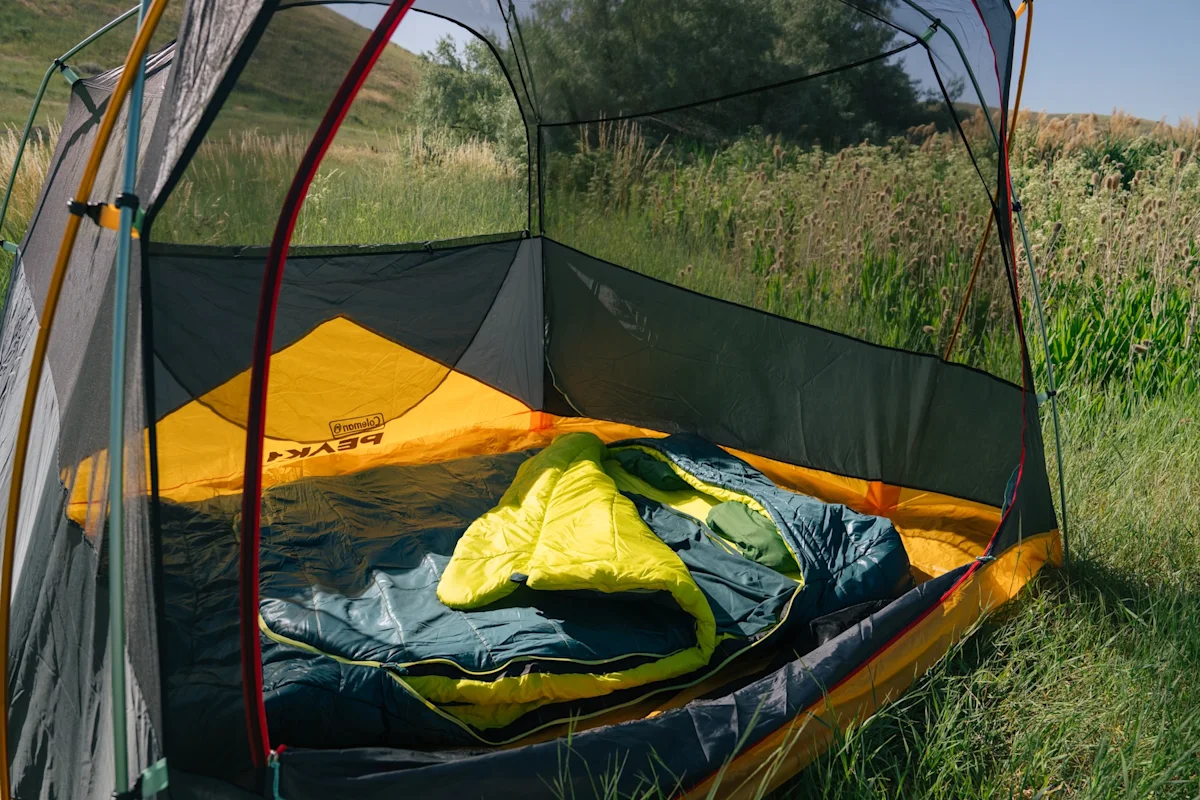
Nemo Jazz Synthetic Double Sleeping Bag
Most Luxurious Double Sleeping Bag: Nemo Jazz Synthetic Double Sleeping Bag, $350
Type of Insulation: Synthetic Stratofiber Shell Fabric: Recycled Polyester Temperature Rating: 30° F Lowest Recommended Temperature: 40° F Dimensions: 78 in x 129 in Weight: 8 lbs, 15 oz
Pros -Pillow and sleeping pad sleeves -Integrated bed sheet
Cons -Its collar is not adjustable -Inside sheet disconnects easily -Not comfortable down to 30 degrees
The Nemo Jazz Double Sleeping Bag is a ludicrously thick and cozy sleeping bag, designed with plenty of features that make it easy to use. These include a sleeve for your pillow and a snap-on top sheet. It was comfortable to sleep inside, but I couldn’t help but feel that the bag got a few obvious details wrong.
The Jazz is built with sleeves to keep slippery camp pillows and sleeping bags from sliding out of place in the night. I also loved the dual two-way wrap-around zippers that let each person control their own ventilation, but also get in and out of the bag without disturbing the other person sleeping inside. Unlike most sleeping bags I’ve tried, the Jazz includes a removable bedsheet that connects via snaps. Whether you personally sleep with a top sheet at home, the ability to use this sheet for extra warmth is really nice. Further, the internal pockets of these sleeping bags are actually big enough to hold a phone—you’d be surprised how rare this is. When the Nemo designers get it right, they really nail it.
There are, unfortunately, drawbacks. Most of these were minor. For example, as much as I appreciated the integrated sheet, I found that it came disconnected throughout the night and is a pain to reattach in the dark. Others were more glaring, like the fact that though the Nemo sleeping bag has a large draft collar to block cold air, it does not feature any sort of hood adjustment cinch or middle snap closure to keep cold air from seeping in while you sleep. It is officially rated for 30 degrees, but I don’t think it would be warm enough to handle those temperatures. I can sort of forgive this, since I found the hoods generally present a difficult design challenge for two-person sleeping bags, but it felt glaring for a $350 option. At nearly 9 lbs, the Nemo Jazz is also heavier than most of the other sleeping bags I tested and does not pack down small. Thankfully, the company sells it with a duffel you can use to carry and store it. Ultimately, these flaws did not ruin the sleeping bag for me. It was plenty comfortable to sleep in and included enough details that I appreciated as I was actually using it.
Overall Rating: 3.5/5 Price: $350

North Face Wawona Bed Double Sleeping Bag
Best Budget Double Sleeping Bag: North Face Wawona Bed Double Sleeping Bag, $199
Type of Insulation: Recycled Polyester Shell Fabric: Recycled Polyester Temperature Rating: 20° F Lowest Recommended Temperature: 20° F Dimensions: 78 in x 120 in Weight: 8 lbs, 12 oz for Regular
Pros - Soft fleece lining is a nice touch
Cons - Only one collar drawcord - No hood
The North Face Wawona Bed Double Sleeping Bag is more bare-bones than some of the other sleeping bags on this list, but it provides a comfortable sleeping experience for two at a budget price. The roomy, rectangular design is large enough to fit two sleepers—including one 6’2 person—without anyone feeling crowded, even with the regular size we tested. The 20-degree temperature rating has kept us comfortable on chilly spring nights, though I haven't pushed it to its absolute limits yet.
The Wawona is pretty basic. It doesn’t have a hood and only comes with one drawcord and toggle so you won’t be able to adjust the collar much to block cold drafts. But it still features a few thoughtful touches that makes it worth a bit extra over the even cheaper bags on the market, like the soft fleece-lined collar at the top and the interior phone pockets on each side. At 8 pounds it's definitely not for backpacking, but for car camping it strikes the perfect balance between comfort and practicality.
Overall Rating: 3/5 Price: $199
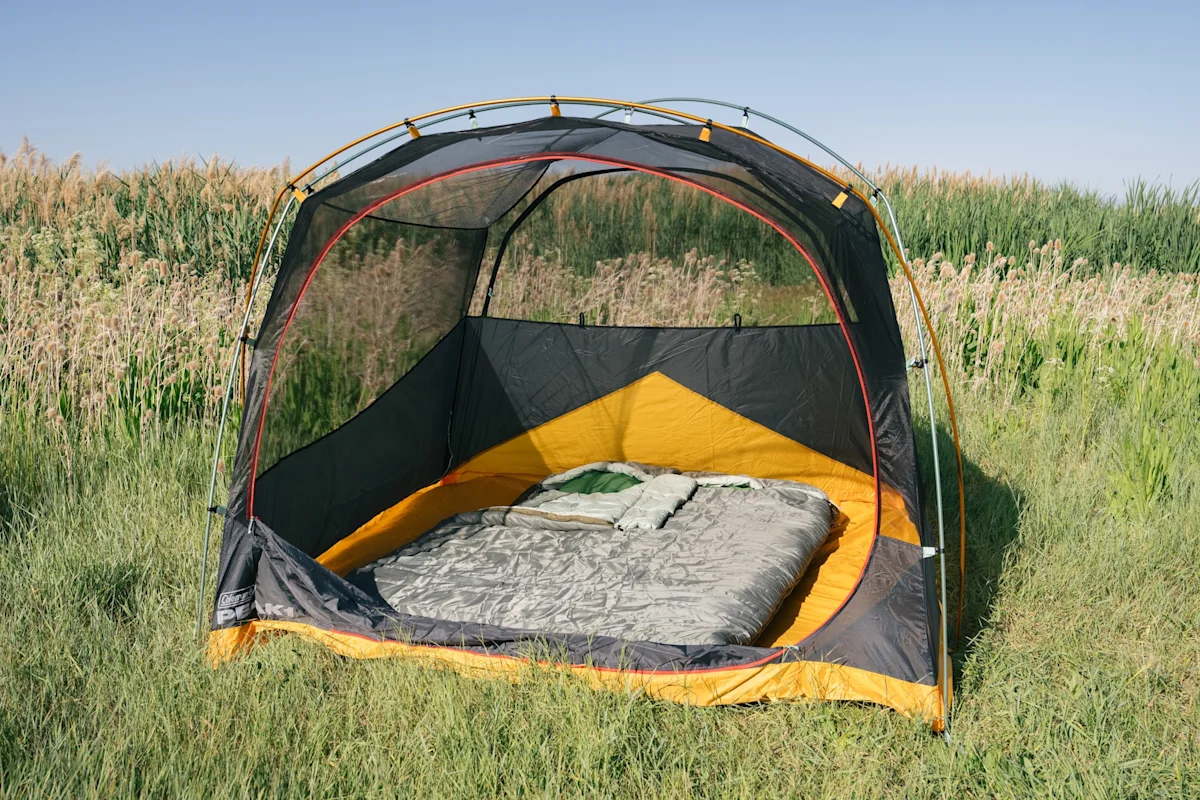
REI Siesta Double Sleeping Bag
Best Synthetic Double Sleeping Bag: REI Siesta Double Sleeping Bag, $250
Type of Insulation: Recycled Polyester Shell Fabric: Recycled Polyester and Polyester Temperature Rating: 20° F Lowest Recommended Temperature: 20° F Dimensions: 77 in x 127 in Weight: 10 lbs, 10 oz
Pros - Four drawcords and toggles for the collar and hood - Toggle and loop in the middle of the hood for extra warmth
Cons - Internal pockets are too small for modern phones
I didn’t think I was going to receive the REI Siesta Double Sleeping Bag in time for this review and I’m so glad I did. The REI Siesta bag is a 20-degree bag with synthetic insulation and a large rectangular shape that accommodates two people with space to spare. It has a lot of neat features that I’d love to see in some of the other bags on this list at a surprisingly affordable price ($249). In particular, I appreciated the lofty draft collar and adjustable drawcord toggles at the collar and hood. It also features a little toggle and loop in the middle of the hood that allows you to divide the hood into two sections to prevent cold air from entering.
A lot of the synthetic bags on this list weren’t quite comfortable down to their reported ratings. To be fair, I’m always too cold for the claimed comfort ratings. And yet, the Siesta actually kept me warm even when the temperature dipped into the 20s while I was sleeping in a camper in Grand Teton National Park. If you tend to overheat, its dual zippers extend all the way around the footbox, so either you or your partner can unzip it around your legs. You’ll never catch me doing this, but you do you.
At just under 8 pounds, this sleeping bag is strictly for car camping—it’s just too big to put in a backpack. But this feels reasonable to me given how large and warm it is. The only thing I really didn’t like about this bag is that the internal pockets aren’t big enough for my iPhone 16 Pro. I always have a million other electronics like camera batteries and headphones that I wanted to keep warm, so the pocket did not go to waste, but it feels like it’s time for a slight redesign. Overall, the REI Siesta Double Sleeping Bag is the warmest synthetic bag I tested and strikes an impressive balance between comfort and price, making it a killer option for pushing your outdoor adventures into the shoulder season.
Overall Rating: 4/5 Price: $250
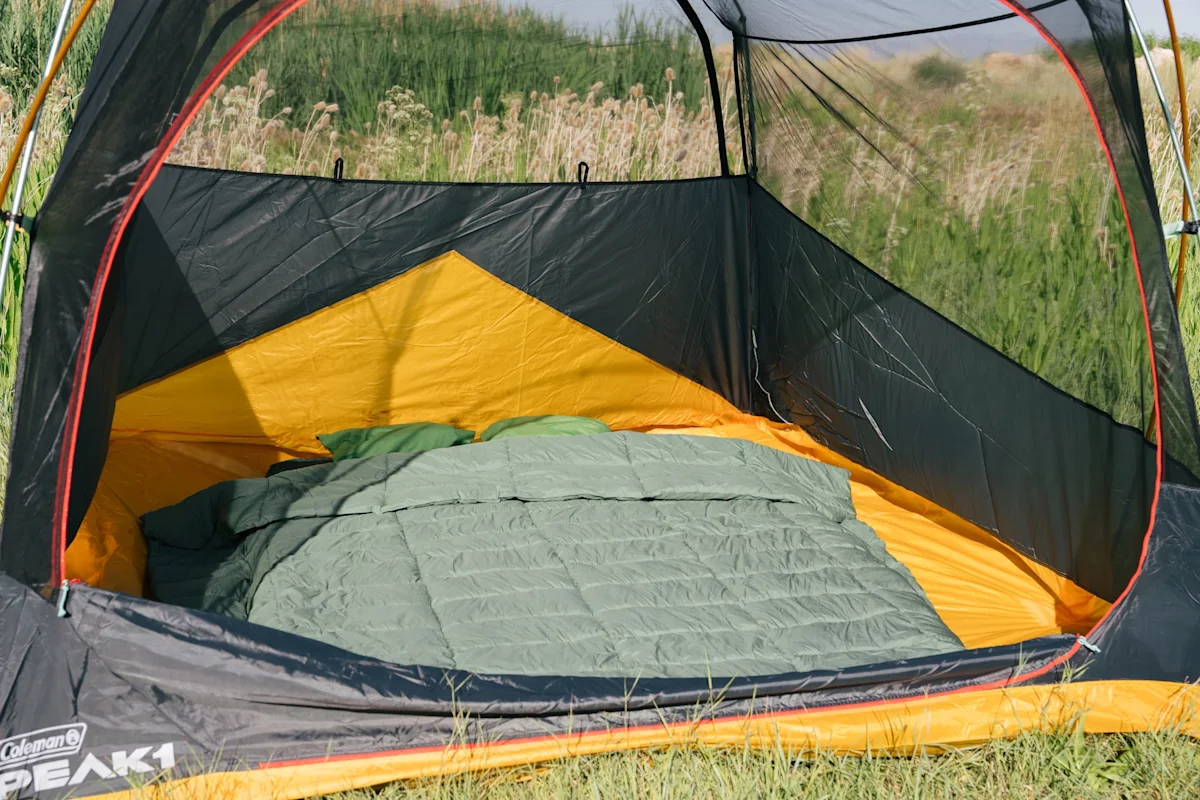
Hest Double Synthetic Comforter
Best Double Sleeping Bag for Summer: Hest Double Synthetic Comforter, $319
Type of Insulation: Recycled Polyester Shell Fabric: Recycled Polyester Temperature Rating: 45° F Lowest Recommended Temperature: 55 and up° F Dimensions: 88 in x 80 in Weight: 4.5lbs
Pros - Versatile - Comfortable
Cons - Expensive for what it is
It’s debatable whether the Hest Double Synthetic Comforter actually counts as a “sleeping bag,” but I love it so much I’m mentioning it anyways. The Hest Double Synthetic Comforter is more or less a regular comforter with a drawcord along the bottom hem to cinch it around your sleeping pad. The rest of the edges are open, allowing sleepers to toss and turn without feeling confined by a mummy or rectangular shape.
This design makes the Hest comforter perfect for summer camping, since it allows for airflow from the top or sides. Hest claims it’s rated for temperatures of 45 degrees, but I doubt most people would be comfortable using this bag in those temperatures. Even the warmest sleeping companion wouldn’t help you overcome the breeze. If it’s at least above 55 degrees, though, you’ll be golden.
There are a few other details that make the Hest worth the $319 price tag. The drawstring is nice for those who toss a lot in their sleep because it won’t shift like a normal comforter and your partner can’t hog more than their share.. The shell fabric is extremely soft and slightly water-resistant and the recycled polyester fill also compresses down significantly. This is good for storage, but also ensures you can stuff the sleeping bag into a normal size washing machine. It’s so versatile that you can also get plenty of use indoors, too—it’s currently strewn on our couch.
Overall Rating: 4/5 Price: $319
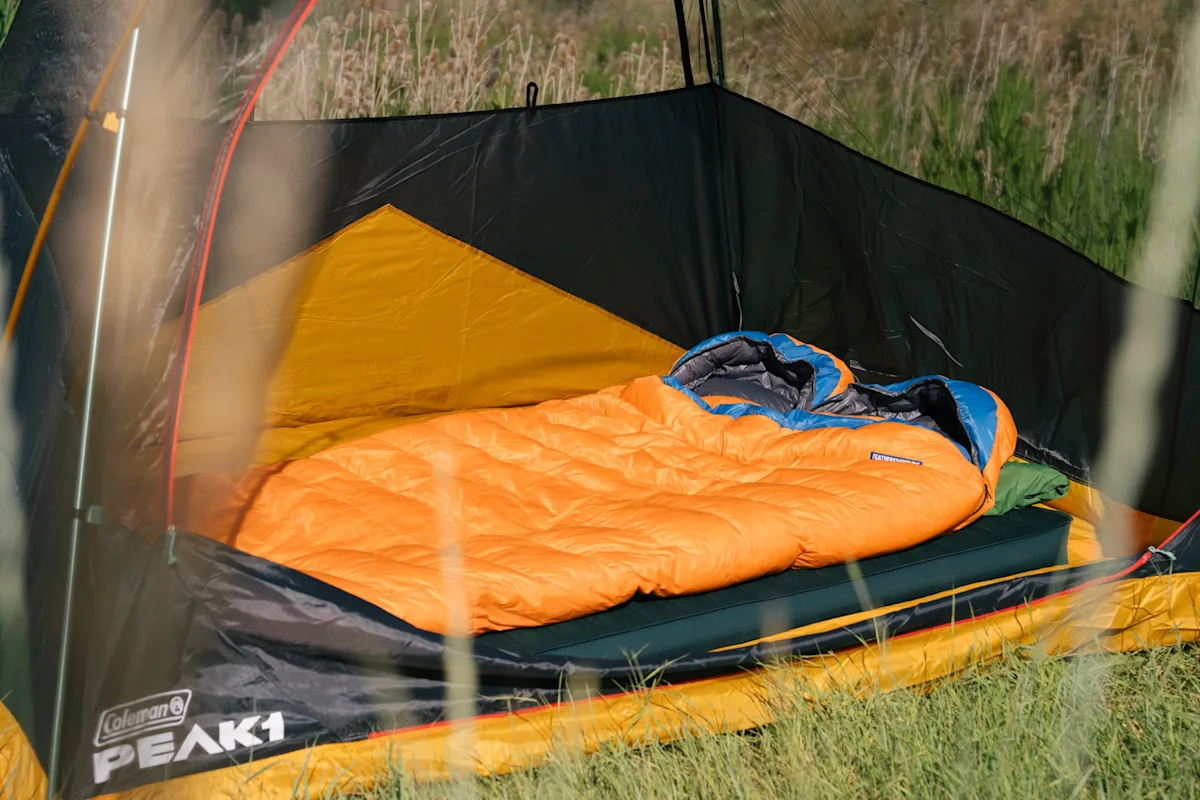
Feathered Friends Spoonbill Double Sleeping Bag
Best Double Sleeping Bag for Winter: Feathered Friends Spoonbill Double Sleeping Bag, $999
Type of Insulation: 950+ Goose Down Shell Fabric: Pertex Endurance UL and Dyneema non-woven floor Temperature Rating: N/A Lowest Recommended Temperature: 0° F Dimensions: 78 in x 104 in Weight: Regular - 2lb 6.3oz / 1086g | Long - 2lb 8oz / 1136g
Pros - Extremely lightweight - The coolest sleeping bag ever made - Made in USA
Cons - So expensive - Single season focus
The Feathered Friends Spoonbill Double Sleeping Bag is one of the finest sleeping bags ever created, with the necessary caveat that it is also extremely niche for cold-weather, ultralight objectives. It delivers winter warmth in an insanely lightweight, compressible package using cutting edge materials like the 10D Pertex Endurance face fabric. Its design is nothing like that of any other sleeping bag on this list, featuring a dual head hood and neck baffle design, so each person has complete control over their warmth. Feathered Friends doesn’t provide a temperature rating but I’ve seen many owners on forums claim it is comfortable to zero degrees or sometimes even lower.
That is astounding, especially since at only 2lb 8oz, this two-person winter bag weighs even less than my zero-degree Mountain Hardwear Phantom one-person zero-degree bag. These weight savings and warmth are achieved by thoughtful design touches—like the fact that the bag’s zippers are a shorter alpine style and that the 10D face fabric is so thin you can see the down through it. Feathered Friends also must expect that anyone who buys the Spoonbill already own two warm, equal-height sleeping pads, since the bag uses uninsulated Dyneema on the bottom to further cut weight. (If you don’t already have it, I’d say the ZPacks Sleeping Pad Strap is essential to keep those two sleeping pads in place.)
Despite costing as much as a new cell phone, the Spoonbill is intentionally light on extra features—no cell phone pockets or pillow sleeves here. (Honestly, this is my personal preference for sleeping bags). It’s cut narrow to save weight, which may make it a tight fit for larger people (or anyone used to sleeping in the backcountry with their puffer on). The separate collars also mean that you can’t snuggle inside. I was only able to test this on a regular camping trip with nighttime temps in the high twenties and was comfortable as a cold sleeper in a bag that’s a little too big for me (my partner is 6’2 so we tested a long), but my partner said his feet got hot in the footbox. Above 50 degrees you’ll likely be roasting, but people who live in the mountain west could easily get use out of this bag all year long.
If I could only have one two-person bag for backpacking out West I would choose the Spoonbill, and I had to include it for those who are trying to get more into winter camping, ultralight camping, or just have appreciation for phenomenal design.
Overall Rating: 5/5 Price: $999
SHOP NOW FROM FEATHERED FRIENDS
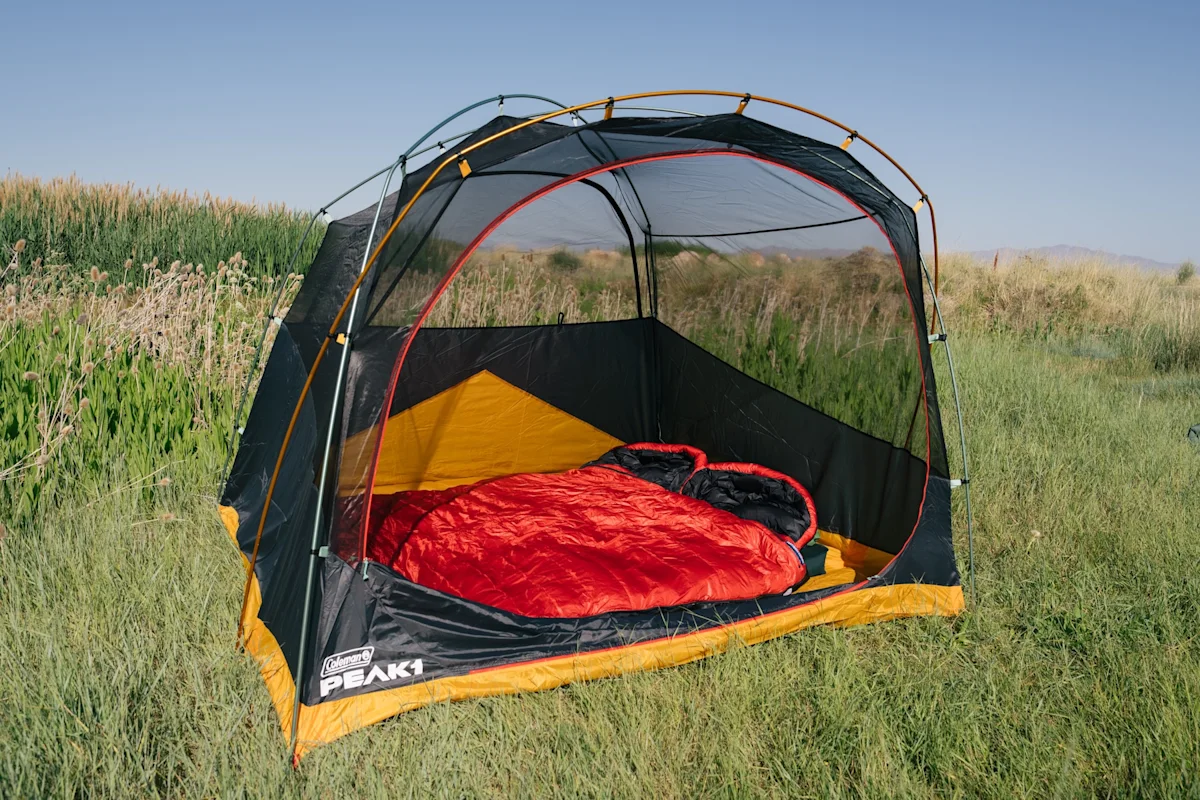
Feathered Friends Penguin YF Double Sleeping Bag
Best Double Sleeping Bag for All-Season Backpacking: Feathered Friends Penguin YF Double Sleeping Bag With Groundsheet and Hoods, $817
Type of Insulation: 900 Goose Down Shell Fabric: Pertex YFuse Temperature Rating: 20° F Lowest Recommended Temperature: 20° F Dimensions: 78 in x 64 in Weight: 4.24lbs (with two hoods and groundsheet)
Pros - Converts between 1P and 2P - Very lofty and warm - Made in USA
Cons - Expensive
For those who want a little more comfort and room than the Spoonbill offers, the Feathered Friends Penguin YF 20 is the answer. This semi-rectangular sleeping bag is packed with an impressive 7 inches of loft on top thanks to its 900+ fill power goose down and if 20 degrees isn’t what you’re looking for, you can choose between 10, 30, and 40 degree bags as well.
The Penguin YF is sold as a single person bag but it can unfold and be used with the Penguin Groundsheet and two Sleeping Bag Hoods to function as a two-person bag. The groundsheet doesn’t provide any insulation so you’ll need to use it with a warm sleeping pad, but the draft tubes did an excellent job keeping cold air out even when temperatures dropped significantly. I didn’t get the chance to use it solo but as someone who does a lot of trips by myself, I also loved the fact that it can function as a one-person quilt so it’s a two-for-one bag.
One note: double check the size chart before you order. Most of the bags on this list have had some wiggle room in the length. Even when technically they shouldn’t have been long enough, my my 6’2” partner has mostly been able to fit into a “regular,” but for some reason he felt a little more constricted in the Penguin. We initially thought that we’d received a regular length because the long felt a little too short for him but maybe it’s just because it’s so much loftier than the same-length Spoonbill.
The Penguin’s premium features also come with a premium price—the optional hood and groundsheet bring the total to over $800—but it’s not that bad when you consider it can also function as a single and double sleeping bag. I’d probably still lean towards zipping two sleeping bags together for my lifestyle but if you’re on the hunt for a two-person bag that allows for cuddling and solo-use, you won’t find anything better for backpacking than the Penguin YF.
Overall Rating: 4.5/5 Price: $817 (with two hoods and groundsheet)
SHOP NOW FROM FEATHERED FRIENDS
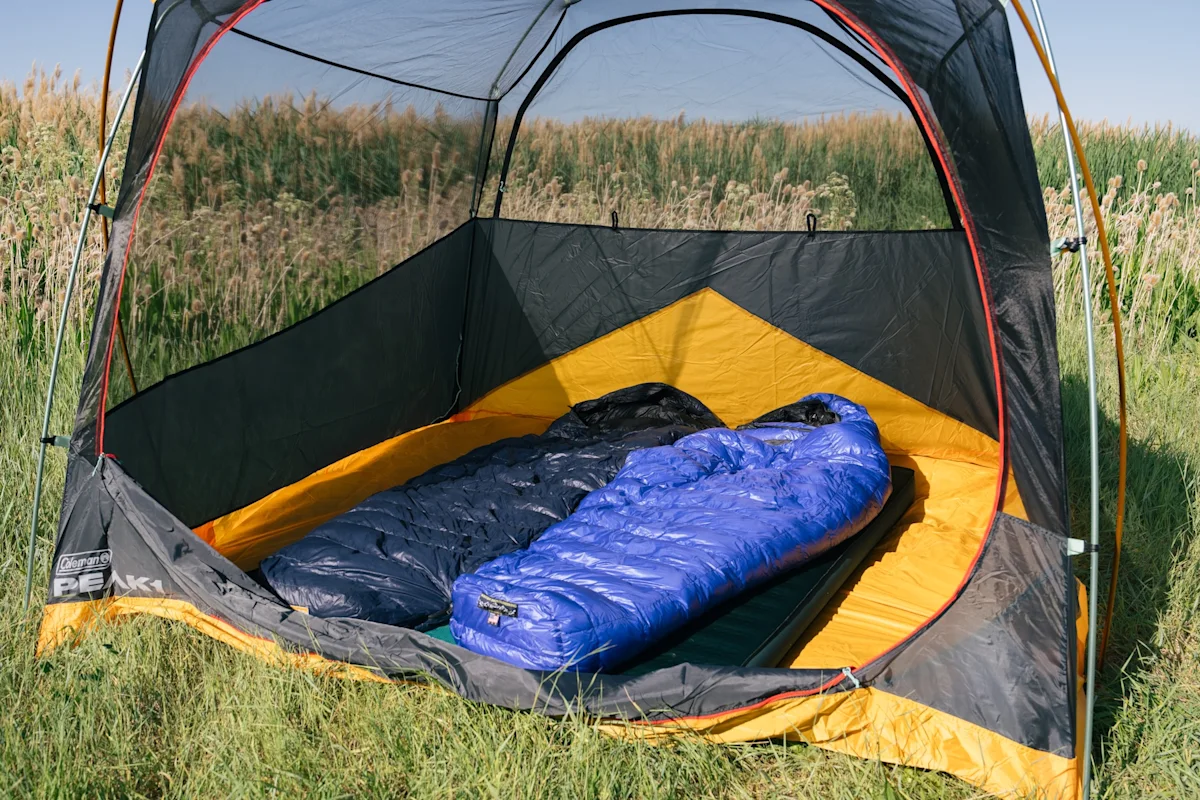
Western Mountaineering Ultralite
A Versatile Option for Coupled Up Campers that Often Go Solo: Western Mountaineering Ultralite, $610
Type of Insulation: 850+ Goose Down Shell Fabric: 12D Ripstop Nylon Temperature Rating: 20° F Lowest Recommended Temperature: 20° F Dimensions: 71 in x 59 in Weight: 1lb, 13oz
Pros - Lighter than a double sleeping bag - Potentially cheaper than a double sleeping bag
Cons - Not ideal for cuddling
A dedicated double sleeping bag makes camp side cuddles easy, while being specifically designed for use by two heat-producing bodies. But some brands offer single sleeping bags with zippers on the right and left sides so two bags can zip together. If I’m honest, I prefer this option for me and my partner. After all, I do a lot of my camping by myself.
To evaluate their capabilities in a pair, I tested a Western Mountaineering Ultralite Sleeping Bag with my partner’s Terralite. The Ultralite is a 20-degree bag that only weighs 1lb 13oz with 850-fill down. It uses a thin, 12D ripstop nylon shell to cut weight, which might make it seem too fragile and performance-oriented for some campers. But in my experience, Western Mountaineering sleeping bags withstand use well. After several thru-hikes, the Western Mountaineering Alpinlite I bought myself is as lofty as it was the day I got it.
We took our pair of Western Mountaineering bags to the Continental Divide in Wyoming in early June. The experience was … okay. Each bag has its own foot box and hood, which makes cuddling a bit challenging, but not impossible. If you do want to snuggle through the night, one person might not be able to use their hood. Of course, if you find yourself in this position, you’ll realize there’s no way to actually close the hood, which means cold air seeps in through the collar all night.
This assumes of course you were able to actually get into your connected sleeping bags in the first place, not an easy task. We found that you couldn’t really zip the sleeping bags together when you were already inside them, which meant you had to first attach them, then shimmy inside.
It would of course be much easier and more luxe to own a sleeping bag that you didn’t have to mate together. But if you often go on trips together and separately, it’s nice to be able to just own and store two sleeping bags instead of three. I also liked that the setup we tested from Western Mountaineering allowed me to use my regular length bag with my partner’s long bag. With all the long two-person bags I tested, there was a lot of excess space in the footbox on my side that made it harder for me to stay warm.
Western Mountaineering was the first company I knew that offered bags that could be mated together, but Big Agnes and Sea to Summit offer this feature for their “men’s” and “women’s” bags as well (this only serves heterosexual couples, which is limiting). Sometimes bags from different brands can be combined too—just make sure the zippers are the same size.
Overall Rating: 4.5/5 Price: $610 - $650
SHOP NOW FROM Western Mountaineering
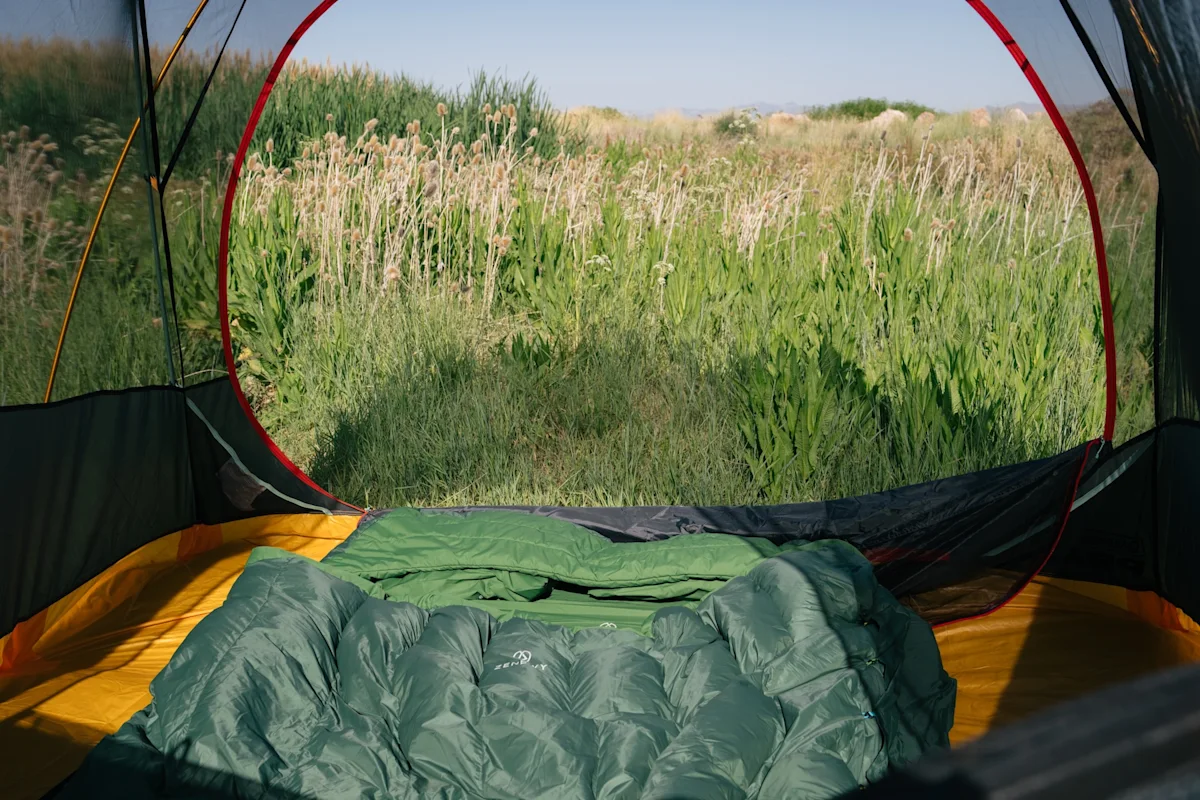
Zenbivy Core Quilt
Best Two-Person Quilt: Zenbivy Core Quilt + Core Sheet, $399
Type of Insulation: Duck Down Shell Fabric: 20D Nylon Taffeta and 50D Polyester Pongee Temperature Rating: 25° F Lowest Recommended Temperature: 35° F Dimensions: 80 L x 92in W Weight: 5 lbs, 2 oz
Pros - Pongee fabric is very soft - No drafts
Cons - Quilts are harder to get in and out of
I first saw the name Zenbivy (a newer brand out of Bellingham) around the thru-hiking world so I was excited to get my hands on its car-camping setup, the Zenbivy Core Quilt and Core Sheet. Since the model isn’t intended for intense backpacking, I took it car camping, where I was impressed by the unique take on a backpacking quilt.
The top quilt clips to a soft Pongee sheet that fits around your sleeping pad with fabric "wings” and a hood, supposedly solving the common problem of drafts that plague traditional quilts. Note that it will only fit on 3-inch sleeping pads—thicker pads like the Nemo Roamer will not work. Quilts can take a bit of trial and error to get right, which is the only drawback to the Core Quilt, but Zenbivy smartly color-coded the hooks to make set up intuitive. In my experience, only subpar quilts are drafty so you get what you pay for and fortunately the Zenbivy system was effective at keeping cold air out.
I don’t always like hoods but I think most people will appreciate the extra warmth offered by the addition. I’ve never liked quilts with open footboxes because my feet get too cold, but Zenbivy’s Fast Footbox allows you to create more space without exposing your toes to the elements. You can’t fully unfold it into a blanket the way you can with some quilts, but Zenbivy does offer some one-person models with this feature.
At 5.1 pounds for both pieces, the Zenbivy Core setup is too heavy for backpacking, but totally fine for car camping. Zenbivy offers lighter “Light” and “Ultralight” beds that both provide better backpacking specs.
Overall Rating: 4.3/5 Price: $399
Frequently Asked Questions
How Should You Wash Your Double Sleeping Bag
Dirt, sweat, and body oil can cause your sleeping bag to become musty and damage the liner. One way to slow this process is to sleep in clean clothes or use a sleeping bag liner. These liners are easy to clean and lengthen the lifespan of your sleeping bag, while also providing additional insulation and warmth.
When it does come time to wash, hand-wash or wash it in a front-loading washing machine that doesn't have an agitator on the delicate setting. Don't use fabric softener. Do use a technical fabric soap like Nikwax's Down Wash Direct for down-filled bags and Nikwax's Tech Wash for synthetic ones.
Air-dry your sleeping bag away from direct sunlight. If you absolutely need to, you can place it in the dryer along with some tennis balls or a towel. Remember not to use the heat setting when you do this, as the heat could shorten the lifespan of your sleeping bag. Don't dry-clean your sleeping bag.
How Do You Store Your Double Sleeping Bag
Keeping your sleeping bag in its compression sack for long periods could affect its loft and, therefore, its ability to provide insulation. Fluff out your sleeping bag after it has been packed away, and store your double sleeping bag by either hanging it or lightly folding it inside out inside the larger mesh sack that it comes with. This helps to eliminate any smells that could get trapped in the liner and preserve the filling.
How Do You Repair Rips & Tears in a Sleeping Bag
If your bag does get torn during an adventure, the quickest fix is a specialized patch that you can easily apply yourself—our favorite is Tenacious Tape. We know that duct tape is like a dirtbag's badge of honor, but it won't last as long as a patch and will wear away over time, leaving a nasty, gluey residue all over your bag. Zipper failures and other more technical repairs are often covered in warranties, so check with the maker to see if you can get a fix for free.
Step up your car camping experience with a well-designed camping lantern and a trustworthy camping chair.






